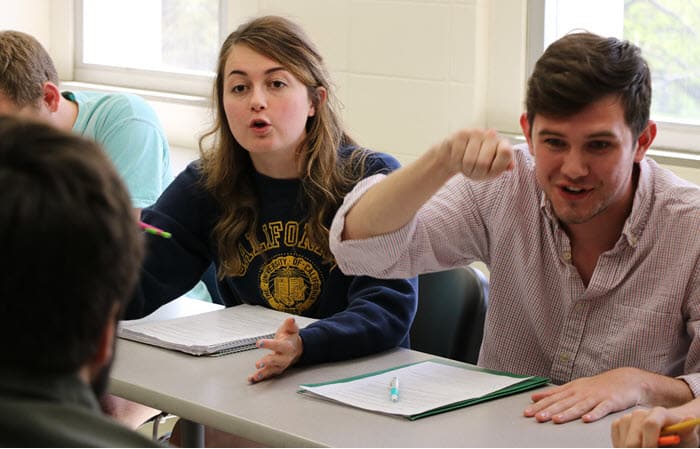By Doug Ward
Strong beliefs about volatile issues can quickly turn class discussions tumultuous, especially during election season.
Rather than avoid those discussions, though, instructors should help students learn to work through them civilly and respectfully. That can be intimidating, especially in classes that don’t usually address volatile issues.
Jennifer Ng, director of academic inclusion and associate professor of educational leadership and policy studies, says transparency is the best way to proceed with those types of discussions. Be up front with students about how emotionally charged issues can be, she told participants at a CTE workshop on Friday. Explain what you are doing and why, but also be clear that you don’t know exactly where the conversation might go.

The CTE website offers advice on how to handle difficult discussions, KU Libraries lists many resources for helping students with media literacy, and Student Affairs lists resources where students, faculty and staff can turn for help in working through personal and professional issues.
Participants at Friday’s workshop shared many ideas on how to make class discussions go more smoothly. Here are a few:
Focus on facts. Politics has become increasingly polarized, making it easy for discussions to turn into heated rants. So help students focus on the facts of an issue or position. What do we know and how do we know it? What has scholarship suggested? Yes, the word “facts” has itself become problematic in a political atmosphere where partisans dismiss anything they don’t like and instead embrace “alternative facts.” Helping students identify what the facts are can help keep discussions away from personal attacks.
Challenge the position, not the person. That, of course, is an approach educators have advocated for years. If we hope to have civil discussions, we have to help students pick apart arguments rather than alienate people they disagree with.
Ask students to imagine an objective approach. Rather than taking a partisan side, ask students to step back and look at arguments from a neutral perspective. What are the strengths and weaknesses of each side? Ng describes this as having students look at the world in a ”meta” sort of way, one that moves them out of the fray and into a broader perspective.
Have students take an opposite view from their own. This is similar to the neutral viewpoint in that it forces students to step back from strongly held positions and consider why others might disagree. Have them write a paragraph explaining that other perspective so they can think through it more meaningfully. Another approach is to have students look at the issues from the perspective of an international student.
Have students create ground rules for discussions. This helps them feel invested in a conversation and reminds them of the importance of respectful discussions.
Have a “pause button.” This is a signal that any student can use to indicate that discussions are becoming too heated and need to stop, at least briefly. The pause can help everyone regroup so the conversation can remain civil.
Give students permission to check out of a conversation. Some instructors allow students to pick up their phones and block out a discussion if it gets too intense. This can also signal to an instructor that the conversation might need to pause. Some instructors allow students to leave the room if things get too heated, but that also draws attention to students who leave.
Don’t assume you have to know what to say. If something comes up that you aren’t prepared to deal with, explain to students that you need to do some research and will get back to them by email or during the next class. Sometimes, instructors just need to listen and try to understand rather than wading into a subject unprepared.
Have students do some writing before they leave class. This can help ease tension, but it also gives instructors a sense of what students are thinking and what they might need to address in a later class.
Take care of yourself. Instructors who deal with emotional classroom issues and listen to students’ personal challenges can suffer what the American Counseling Association calls vicarious trauma or compassion fatigue. This is tension brought on by dwelling on stories of traumatic experiences that others have shared. A recent article in Faculty Focus offers suggestions for dealing with these types of issues.
KU’s interim provost, Carl Lejuez, offered an excellent goal for all discussions at the university. In his weekly message to the campus this week, Lejuez wrote:
“There is no weakness in being respectful. There is no shame in being considerate. There is nothing wrong with a desire to be a community that cares for its people. Put another way, KU is at its best when we are civil, understanding and compassionate.”
Briefly …
Forthcoming webinars led by the university’s Technology Instruction and Engagement team will focus on using MediaHub and the Blackboard grade center. You will find a full list of workshops on this site. Past webinars are available on KU IT’s YouTube channel, and the team’s resource page, How to KU, offers help on Office 365, Sharepoint, and several Adobe applications. … The Library of Congress has created what it calls the National Screening Room, an archive of films that can be downloaded or watched online. … Edutopia offers strategies for remembering students’ names. … Wichita State’s Campus of Applied Sciences and Technology will pay provide a free education, relocation expenses for incoming students who live more than 75 miles away, and housing and cost-of-living stipends, according to Education Dive. The program, which is funded by the Wichita Community Foundation, is intended to address a shortage of skilled workers in aviation fields like sheet metal assembly and process mechanic painting. Students are guaranteed jobs after they graduate.